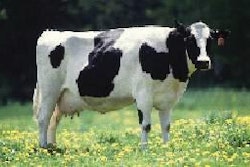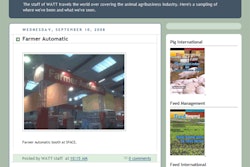The quest to become the greenest generation is resonating with increased urgency in feed and food circles as producer and supplier come to grips with agriculture's responsibility for creating a more sustainable envrionment.
Behind the pursuit of a greener economy is a global revolution fueled in large part by deep-felt concern over renewable fuel production and its likely link to the spiraling cost of feed and food. As the debate between corn for fuel and corn for feed boils over, opinions from those within agriculture have fallen primarily into two camps: those who strongly believe that the diversion of corn to ethanol is behind the rising costs of commodities and those who see ethanol as the savior for rural-based economies.
Strong arguments have blazed from both sides. Recent weeks saw the United States Department of Agriculture's (USDA) chief economist predicting continued rise in commodity prices and depression of the livestock industry there due to ethanol production while the leadership of that country's corn growers and renewable fuels proponents say such conclusions are faulty at best and point the finger to other factors, such as rising oil prices.
Fuel for debate
Wrapped within the fabric of the debate over corn for ethanol versus corn for livestock is the overriding question of addressing the need for renewable and alternative fuels. One of the questions volleyed back and forth is that of just how environmentally friendly is corn-based ethanol production? Statistics are no scarcity on either side of the issue, with skeptics pointing to the energy necessary for the production of ethanol, the depletion of natural resources and poorer fuel efficiency while those in the industry claim improved technologies make such arguments antiquated.
So, can agriculture—can the feed industry—be the greenest generation? That question was raised as the theme for Alltech's 24th International Animal Health and Nutrition Symposium held in April in Lexington, Kentucky, USA. The symposium ended on a call for action for agriculture to take the lead in creating the greenest generation and embrace the wide ranging solutions available to the world. These newest green technologies, stressed speaker upon speaker, should be the focus for agriculture's future, not the clash over corn.
Alltech's founder and president, Dr Pearse Lyons, challenged the symposium audience by urging them to rethink technology and business practices and transform the agricultural industry.The future of the next generation, he stressed, will depend on redefining our mind set and it is the current generation's responsibility to feed a hungry world. "Necessity is the mother of invention," he noted. "We must constantly look for sustainable energy resources."
But can agriculture develop sustainable energy resources, protect the environment and feed a growing global population? How does the feed industry choose among these priorities for a future generation?
You don't. It shouldn't be a question of starvation versus environmental deprivation at all, because one isn't more important than the other, pointed out Osler Desouzart. Desouzart is president of OD Consulting and formerly with Sadia, Perdigao and Doux Frangosul in Brazil. He is a frequent lecturer worldwide on international trade and competition in the agro-food business.
One of three noted agricultural policy makers to debate feed, food and fuel issues as part of Alltech's Synposium, Desouzart was joined by Mike Johanns, former secretary of the USDA and David Byrne, former European Union Commissioner for Health and Consumer Protection.
When asked about the competing forces on feed and food and the need for sustainability, Desouzart said the answer is easy. If technologies are allowed to be applied to the matters of both fuel and food, then the growing global population can be satisfied and more environmentally friendly practices will rise to the top.
Desouzart said agriculture will produce enough cereals, roots, sugar, vegetable oils, meat, and other foods to meet the growing demand. Looking for the right figures on how much meat will need to be produced is not the issue. "The issue is that there is going to be production and there is going to be consumption," he said in challenging agriculture to think beyond traditional practices. "We have to do it, we will do it. We can do it without destroying the planet." Key, said Desouzart, is allowing the feed industry to do its job and for science—not sensationalism and faulty logic—to prevail.
All three industry leaders taking part in the food and fuel debate underscored the need for further investment in science and for the application of emerging research and technologies to address the issues surrounding food, feed and fuel and its impact on the environment.
Consumer confidence
In addition to debating agriculture's role in feeding the world and safeguarding the environment, the industry leaders discussed how agriculture can gain consumer confidence in a safe food supply, yet another stepping stone to becoming a truly green industry.
Byrne told the nearly 2,000 assembled that preserving consumer confidence is paramount to a successful food production system, and pointed to his days addressing the BSE issue in Europe. "I learned a lesson at that time that to regain and retain consumer confidence, you have to be in position to show the public that there is somebody or some entity in charge of this, that a plan has been developed, and that the public knows what that plan is and that those in charge can identify for the public that that plan is working. If you have these factors in place, you can then go to the public and say that the problem has been solved, the issues have been reformed, the demon is gone. I believe that is critically important."
When asked about the impact ethanol production is having on the costs of commodities and available environmental resources, Secretary Johanns fell back on his long-standing position as a proponent of renewable energy produced in the North American cornbelt, summing up his thoughts by stating, "Biofuels can be part of what I call an American Rural Renaissance."
Agriculture's history of adopting new technologies underscores the industry's ability to become innovative once again and address the need to feed a hungry world while safeguarding the planet in ways that do not force one to be addressed at the expense of the other.
Reducing the carbon footprint
Feed and livestock production can be central to that process, he asserted. "So how do we get to be the greenest generation? The better our feed conversion, the less impact on the environment." Secretary Johanns pointed out that if agriculture can improve the efficiencies of livestock, the carbon footprint of agriculture can be reduced. One of the ways agriculture can stay cutting edge is to invest in scientific research and development.
Some in the feed industry have been taking such advice to heart in addressing the need for alternatives to grain-based renewable fuels. Both Alltech and Genecor, a division of Danisco, recently announced plans to move forward with biorefinery projects that utilise cellulose rather than grain, for production of renewable fuel and other value-added products.
Alltech's rural community biorefinery is claimed to be one of the first in the United States to utilize cellulose, such as switch grass, corn cobs and corn stover, at raw material levels of up to 30 percent. This will be converted to ethanol and other value-added products.
"Cellulosic ethanol utilizes raw materials which are readily available and which alleviate the current demand for grain for ethanol production. With commodity prices reaching an all-time high and with ethanol production forecast to account for 30 percent of the U.S. corn harvest by 2010, we must focus our attention on a sustainable path to alternative energies," said Dr Lyons.
The biorefinery will have an impact on Kentucky's agricultural production by housing dairy and beef cattle to be branded under the Kentucky Proud label. Such actions could be a significant step toward addressing Kentucky's $250 million milk deficit and this concept has already drawn interest from the Netherlands, Ireland, South Africa and China, according to Alltech's leadership.
The facility will also have the capability to produce algae, a plant that needs little besides sunlight and carbon dioxide, and yet it can produce 5,000 gallons of biofuel per acre per year compared to the 400 gallons produced by corn.
The company says the science does not stop there. As part of the project's research component, Alltech will coordinate R&D activities with the University of Kentucky and the University of Cincinnati. Researchers will work to identify and address process improvements, develop economically and environmentally sound technologies, as well as use process simulation to reduce raw material costs and optimize energy utilization.
Focus on cellulose
On the heels of Alltech's announcement that it had received a US Department of Energy grant that would allow its rural biorefinery project to move forward, DuPont and Genencor, a division of Danisco A/S, announced an agreement to form DuPont Danisco Cellulosic Ethanol LLC, a 50/50 global joint venture to develop and commercialize technology for the production of cellulosic ethanol.
The partners plan a three-year investment of US$140 million, which will initially target corn stover and sugar cane bagasse. Future targets include multiple lingo-cellulosic feedstocks, including wheat straw, a variety of energy crops and other biomass sources.
"By combining the world-class capabilities of DuPont and Danisco, our joint venture will offer the technology standard for cellulosic ethanol production," said Danisco CEO Tom Knutzen. "This joint venture will be a powerhouse of discovery, development and engineering. It represents a major step forward in Danisco's new strategic intent to be a leading force in the field of industrial biotechnology."
Through the scientists and technologies of both companies, DuPont Danisco Cellulosic Ethanol LLC will launch an accelerated effort to integrate the unique cellulosic processing capabilities of both companies to economically produce ethanol from non-food sources. The parent companies will license their combined existing intellectual property and patents related to cellulosic ethanol. The goal is to maximize efficiency and lower the overall system cost to produce a gallon of ethanol from cellulosic materials by optimizing the process into a single integrated technology solution, according to spokespersons for the partnership.
The joint venture will scale up in the United States what the companies say is an optimized technology package for corn cobs by integrating the proprietary DuPont pretreatment and ethanologen technologies with the enzyme technology of Genencor, while DuPont continues to analyze the collection and storage of cellulosic feedstocks. Its first pilot plant is expected to be operational in the U.S. by 2009, and its first commercial-scale demonstration facility should be operational within the next three years. The joint venture will be headquartered in the United States and will be formed after necessary regulatory approvals.
The companies say the joint venture will license its technology package directly to ethanol producers for deployment globally, as well as through the establishment of regional cellulosic ethanol affiliates. The regional ethanol affiliates will invest in equity interests with strategic partners, including ethanol producers and energy companies, to enable rapid deployment of the joint venture's cellulosic ethanol technology at commercial scale, say the partners. The joint venture's technology package can be used both as an add-on to existing ethanol plants as well as the design basis for a stand-alone cellulosic ethanol facility. The joint venture expects to enable production of commercial volumes of cellulosic ethanol by 2012.
Green building
Signs of a greener generation can be found elsewhere in the feed industry as well, with some of the largest players changing the way they do business. One of those making changes from the ground up is Novus International Inc. The company is investing US$20 million in a new 90,000-square-foot office building to be completed late this summer in St. Louis, Missouri, USA. The facility is being designed to achieve Leadership in Energy and Environmental Design (LEED) platinum certification from the U.S. Green Building Council, the highest level of LEED certification in that nation.
Richard L. Bond, president and CEO of Tyson Foods, has been one of the most vocal in stating his concerns over the impact corn-based ethanol is having on the price of grain. At the same time, Tyson is not just raising objections to corn-based ethanol production, but also engaging in alternative activities for sustainability. According to the company, it has reduced its water usage by 15 percent per pound of finished product over the past two years and intends to implement additional water conservation measures in fiscal 2008. Through its alliances with other businesses, Tyson expects to produce up to 250 million gallons of renewable fuel a year produced from animal fat over the next three to four years.
Addressing both environmental concerns and the need to feed the world without destroying it, in 2006 Tyson committed to donate 10 million pounds of protein over three years to America's Second Harvest—The Nation's Food Bank Network. According to company spokespersons, the company is on track to exceed this goal ahead of schedule.
And there are more examples within the industry. Equipment and transport manufacturers, for example, are focusing on development of more energy efficient trucks and milling equipment. Ingredient manufacturers are working to reduce the impact of nutrients on the environment, with new products hitting the market at an amazing frequency.
"We believe sustainability is essentially doing the right thing, whether it involves protecting natural resources, creating alternative energy or feeding the hungry," sums up Bond.





.jpg?auto=format%2Ccompress&fit=crop&h=167&q=70&w=250)











